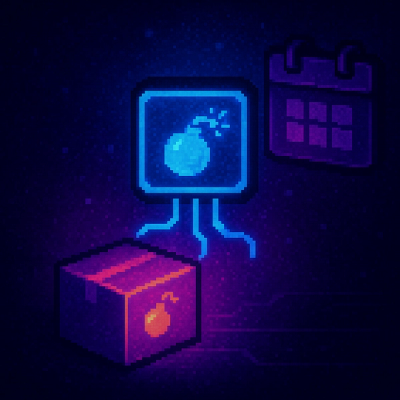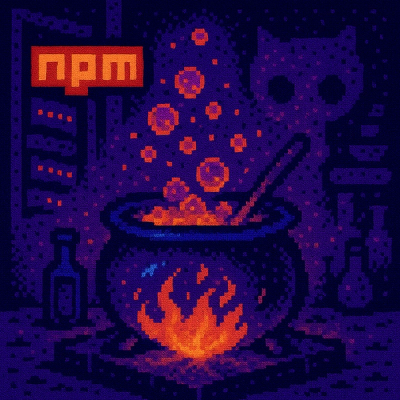
Research
/Security News
9 Malicious NuGet Packages Deliver Time-Delayed Destructive Payloads
Socket researchers discovered nine malicious NuGet packages that use time-delayed payloads to crash applications and corrupt industrial control systems.
coil-react
Advanced tools
A React Framework with build in routing service and state management.
In the past, when we are dealing with state management, the first thing comes to mind is Redux, perhaps it is a great tool when there is a large project, but it becomes an overkill to relatively small project, and it has quite steep learning curve, where you need to understand how a state is manipulated, what reducer, action, store are, and furthermore there are thunk and saga.
Why don't we use Context API from vanilla React? Yes, it is a great tool when splitting a large state into small, but it will end up with tones of Context.Provider or Context.Consumer somewhere in your outermost component.
That's why Recoil.js comes into play. With its easy-to-learn API and hooks, building small and strong state management application is not a problem anymore.
However, with the flexibility created by React and Recoil, thinking about the folder structure is another nightmare too, also, installing libraries like react-router-dom and other core libraries will make your package.json ugly.
Finally, Coil-React suggested a way in dealing with all problems mentioned above.
With Dynamic State Injection, we can see what part of state is relative to the current module we are doing. Also, we can split the state from a large piece of thing into small to achieve separation of concern.
React provided an API to lazy-load our components and provide a fallback UI, but currently it only supports default export, and we think that it is not good in Developer Experience (DX), so we provided an function async() to support named export.
In vanilla React, when we need to fetch data from the Internet, we need to have an ajax call in React.useEffect or ComponentDidMount. However, we think that this will somehow pollute the component because we will have our fetching function in the component, and a component should only be responsible to display the UI.
To make your component cleaner, we wrapped your module component with a function injectLifeCycle, where it will call your didMount and didUpdate function, while your actual component remain the same.
Besides, with combination of React Hooks and Recoil, we can declare an action or state updater outside React Component, which will make the component much cleaner.
$ npm install coil-react
or
$ yarn add coil-react
+ My Awesome Project
| +- src
| | +- component (your re-usable components)
| | +- module (Page As Module)
| | | +- your-module
| | | | +- Main (Component Folder)
| | | | | +- index.tsx
| | | | +- type.ts (Module Typing)
| | | | +- index.ts (State & Action creator)
| | | | +- hooks.ts (Module related hooks)
| | +- util
| | +- index.ts
| +- package.json
To Start using
coil-react, in your entry js/ts file, namelyindex.jsImport the followings:
MyAwesomeProject/src/index.ts
// Before
import React from "react";
import ReactDOM from "react-dom";
ReactDOM.render(<App />, document.getElementById("my-app"));
// Now
import {startApp} from "coil-react";
import {useToast} from "@chakra-ui/react";
// We will cover that later
import {MainComponent as App} from "module/myFirstModule";
const useGlobalErrorHandler = () => {
// You use other libraries' hooks here
const toast = useToast();
return (error: any) => {
// Error Handler
if (error instanceof Error) {
toast({
title: "Error Occurred",
});
}
};
};
startApp({
MainComponent: App,
entryElement: document.getElementById("my-app"),
// This could catch unhandledPromiseRejection and Error thrown.
useError: useGlobalErrorHandler,
});
If you find yourself repeating the same action of creating new module, why don't you try using Coil React CLI
We are going to create a simple page which will have a click counter.
MyAwesomeProject/src/module/myFirstModule/type.ts
export interface State {
count: number;
}
MyAwesomeProject/src/module/myFirstModule/index.ts
import Recoil from "recoil";
import {injectLifeCycle, useCoilState} from "coil-react";
import type {State} from "./type";
import {Main} from "./Main";
const initialState: State = {
count: 0,
};
export const MyFirstModuleState = Recoil.atom({
key: "MyFirstModuleState",
default: initialState,
});
export const useMyFirstModuleAction = () => {
const {getState, setState} = useCoilState(MyFirstModuleState);
const add = () => {
setState((state) => (state.count += 1));
};
return {
add,
};
};
export const MainComponent = injectLifeCycle(Main, useMyFirstModuleAction);
MyAwesomeProject/src/module/myFirstModule/hooks.ts
import Recoil from "recoil";
import {MyFirstModuleState} from "module/myFirstModule";
import type {State} from "./type";
export const useMyFirstModuleState = <T>(fn: (state: State) => T): T => {
const state = Recoil.useRecoilValue(MyFirstModuleState);
return fn(state);
};
MyAwesomeProject/src/module/myFirstModule/Main/index.tsx
import React from "react";
import {useMyFirstModuleState} from "module/myFirstModule/hooks";
import {useMyFirstModuleAction} from "module/myFirstModule";
export const Main = React.memo(() => {
const count = useMyFirstModuleState((state) => state.count);
const {add} = useMyFirstModuleAction();
return (
<div>
<span>count: {count}</span>
<button onClick={add}>Add</button>
</div>
);
});
What if there is module that will fire an AJAX call to server while the module(page) loads ?
For simplicity, we will start from
module/instead of full path
Before diving into actual code, let's take a look at the
History API
In Coil-React, we have a hook call useHistory.
Basically this hooks is the same as what react-router-dom's does, but we added a powerful function that help us deal with state between history.
import {useHistory} from "coil-react";
// Introducing history.pushHistory
// by doing this, we can extract the state using location.state
const usage1 = () => {
const state = 100;
history.pushHistory(state);
};
const usage2 = () => {
const tab = "overview";
const state = 100;
history.pushHistory(`/my-page/${tab}`, "keep-state");
history.pushHistory(`/my-page/${tab}`, state);
};
In Coil-React, we have two lifecycle methods,
onMountonRouteMatchedimport {injectLifeCycle} from "coil-react";
import {Main} from "./my/component";
// onMount
const useStateAction = () => {
const onMount = () => {
console.info("Component Did Mount!");
};
return {
onMount,
};
};
export const MainComponent = injectLifeCycle(Main, useStateAction);
import {injectLifeCycle, useHistory} from "coil-react";
import {Main} from "./my/component";
import type {Location} from "history";
type Tab = "overview" | "detail";
interface RouteParam {
// This must be the same as where you declare <Route path='path/:tab' component={MainComponent} />
tab: Tab;
}
interface State {
id: number;
}
// onRouteMatched
const useStateAction = () => {
const history = useHistory<State>();
// This lifecycle will be fired every time the history is updated
const onRouteMatched = (routeParam: RouteParam, location: Location<Readonly<State> | undefined>) => {
const tab = routeParam.tab;
// As mention before, we can extract the history state from location.state
const myState = location.state;
// You may do some data fetching here
};
const changeTab = (tab: Tab) => {
history.pushHistory(`/my-page/${tab}`, "keep-state");
};
const pushStateToHistory = () => {
const state: State = {
id: 1234,
};
history.pushHistory(state);
};
return {
onRouteMatched,
};
};
export const MainComponent = injectLifeCycle<RouteParam, State>(Main, useStateAction);
module/dataFetching/type.ts
export interface State {
filter: MyFilter;
data: MyData | null;
}
export interface MyFilter {
id: string | null;
}
export interface MyData {
id: number;
name: string;
age: number;
}
module/dataFetching/index.ts
import Recoil from "recoil";
import {injectLifeCycle, useCoilState, useHistory} from "coil-react";
import type {State, MyFilter} from "./type";
import {Main} from "./Main";
import type {Location} from "history";
const initialFilter: MyFilter = {
id: null,
};
const initialState: State = {
filter: initialFilter,
data: null,
};
export const DataFetchingState = Recoil.atom({
key: "DataFetchingState",
default: initialState,
});
export const useDataFetchingAction = () => {
const {getState, setState} = useCoilState(DataFetchingState);
const history = useHistory<MyFilter>();
// Lifecycle Method 2
// We don't use routeParameter here
const onRouteMatched = (routeParameter: any, location: Location<Readonly<MyFilter> | undefined>) => {
// This will fire after page load / history update
const filter = location.state ?? initialFilter;
setState((state) => (state.filter = filter));
fetchData();
};
const pushFilterToHistory = (id: 1234) => {
// By pushing the filter to history, it will trigger an update to call onRouteMatched, so we can extract that from location, to do the fetch data again
history.pushHistory({id});
};
// This function should consider private, so we do not return it
const fetchData = async () => {
const filter = getState().filter;
const data = await MyAJAXCall.function(filter);
setState((state) => (state.data = data));
};
return {
onRouteMatched,
pushFilterToHistory,
};
};
export const MainComponent = injectLifeCycle<any, MyFilter>(Main, useDataFetchingAction);
module/dataFetching/Main/index.tsx
import React from "react";
import {useDataFetchingState} from "../hooks";
import {useDataFetchingAction} from "module/dataFetching";
export const Main = React.memo(() => {
const name = useDataFetchingState((state) => state.data?.name || "");
const age = useDataFetchingState((state) => state.data?.age || 0);
const id = useDataFetchingState((state) => state.data?.id || 0);
const {pushFilterToHistory} = useDatFetchingAction();
return (
<div>
id: {id}
name: {name}
age: {age}
Friends:
<span onClick={() => pushFilterToHistory(1234)}>Jamyth</span>
</div>
);
});
FAQs
A React Framework combined react-router, recoil, react
We found that coil-react demonstrated a not healthy version release cadence and project activity because the last version was released a year ago. It has 1 open source maintainer collaborating on the project.
Did you know?

Socket for GitHub automatically highlights issues in each pull request and monitors the health of all your open source dependencies. Discover the contents of your packages and block harmful activity before you install or update your dependencies.

Research
/Security News
Socket researchers discovered nine malicious NuGet packages that use time-delayed payloads to crash applications and corrupt industrial control systems.

Security News
Socket CTO Ahmad Nassri discusses why supply chain attacks now target developer machines and what AI means for the future of enterprise security.

Security News
Learn the essential steps every developer should take to stay secure on npm and reduce exposure to supply chain attacks.